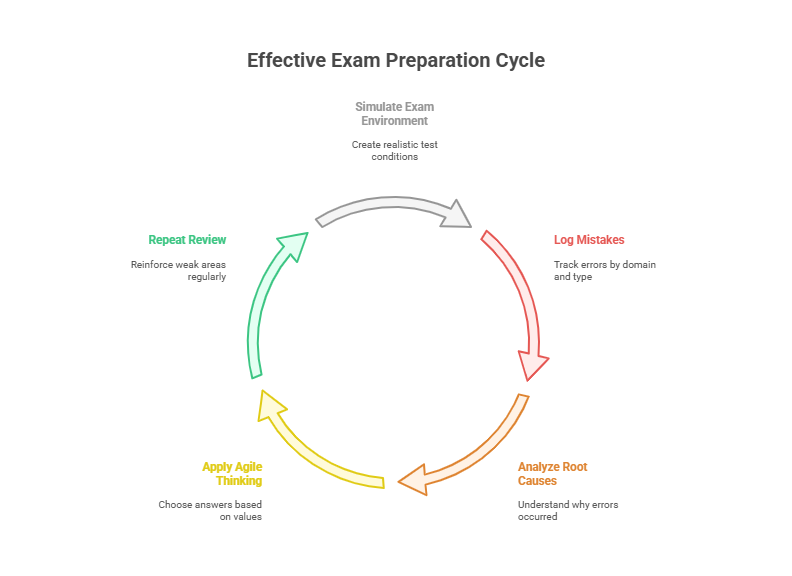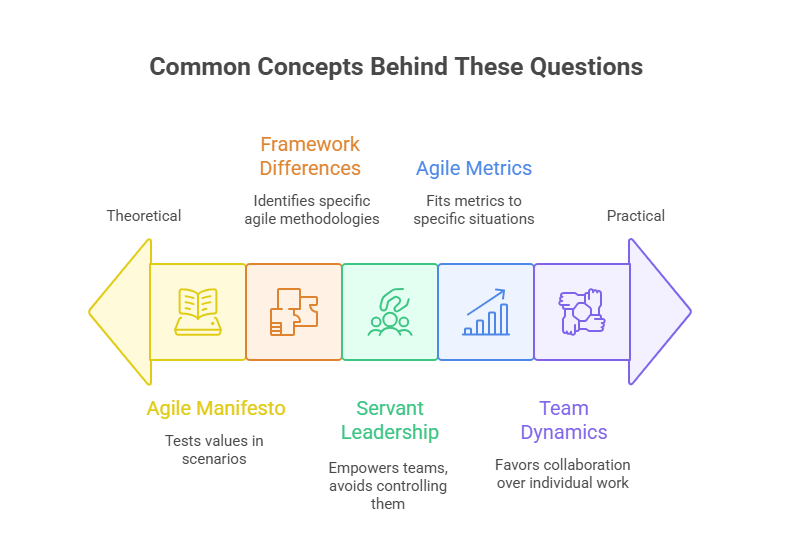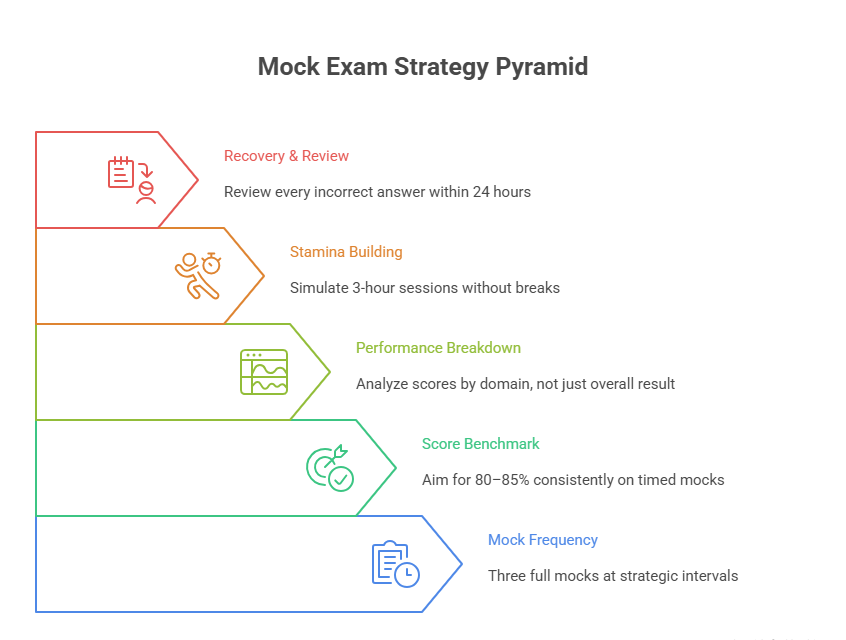Top 25 PMI-ACP Exam Questions Answered by Experts (2025 Edition)
Passing the PMI-ACP exam isn’t about luck — it’s about preparation aligned with how the test is actually built. You can read guides all day, but until you face realistic, scenario-driven questions, you won’t know where you stand. That’s why we’ve compiled the top 25 most accurate, expert-reviewed PMI-ACP questions that mirror the exam's tone, structure, and cognitive level. Each question isn't just followed by an answer — it includes expert reasoning to help you think like a real-world agile practitioner.
In this blog, we’re not just dropping a question bank. We’re handing you a step-by-step plan to maximize your practice. From how to interpret agile scenarios to learning through feedback and mock simulations, everything is designed to build confidence, speed, and decision-making skills. This is your strategic guide to real PMI-ACP readiness — not surface-level cramming.
How to Use Sample Questions Effectively
Replicating Exam Conditions
Most candidates fail to simulate the actual environment, which is where performance gaps start to show. To truly benefit from sample questions, treat every session like the real thing. That means a quiet, distraction-free setup, a strict timer set for 180 minutes, and zero access to notes. This helps condition your brain to stay focused for the full 3-hour duration, reducing burnout on exam day.
Use a mix of digital and printable question sets. While online platforms replicate the test interface, printed sets help test your internalized knowledge — no back buttons, no hints, no lifelines.
Tracking Mistakes for Targeted Learning
If you’re not reviewing every mistake, you’re wasting your time. Maintain a mistake log with root-cause analysis for each wrong answer. Did you misunderstand a term? Misread a question? Miss a keyword like “most likely” or “best next step”? The goal is to identify patterns in your thought process, not just memorize correct answers.
Break errors into categories:
Conceptual misunderstanding
Terminology confusion
Rushing or fatigue
Distractors misread
Once you’ve classified the mistake, align it with a knowledge area (like Agile Planning or Value-Driven Delivery). That’s how real improvement happens.
Applying Agile Thinking, Not Just Memory
PMI-ACP doesn’t reward rote memorization. It tests your ability to apply agile frameworks dynamically. Each question reflects a team situation, and your job is to think like a servant leader, facilitator, or agile coach — not a textbook parrot.
Instead of memorizing what XP or Scrum prescribes, ask: How would this look on my team? Train yourself to choose the answer that reflects agile values and team empowerment, not rigid process enforcement. That mindset shift is where real mastery — and high scores — come from.
Top 25 PMI-ACP Exam Questions and Answers
| # | PMI-ACP Exam Question | Expert Answer |
|---|---|---|
| 1 | What is the primary benefit of using a burndown chart? | To track remaining work in a sprint and help the team forecast progress. |
| 2 | Which Agile framework emphasizes limiting work in progress? | Kanban. |
| 3 | What is the role of a servant leader in Agile? | To support, enable, and remove blockers for the team. |
| 4 | Which ceremony is held to inspect and adapt the product? | Sprint Review. |
| 5 | How does Agile promote customer collaboration? | Through frequent feedback cycles and stakeholder involvement. |
| 6 | What is the ideal team size in Scrum? | 5–9 members. |
| 7 | What does velocity measure? | The amount of work a team completes in a sprint. |
| 8 | What technique is used for estimating in Agile? | Planning Poker or Story Points. |
| 9 | What is the primary goal of a retrospective? | Continuous improvement of the team’s process and collaboration. |
| 10 | What Agile methodology uses pair programming? | Extreme Programming (XP). |
| 11 | How does Agile respond to change? | By welcoming changing requirements, even late in development. |
| 12 | What artifact defines the scope of a sprint? | Sprint Backlog. |
| 13 | Which Agile practice focuses on delivering the simplest solution? | YAGNI (You Aren’t Gonna Need It) from XP. |
| 14 | What is the benefit of test-driven development (TDD)? | Improves code quality and reduces bugs early. |
| 15 | How does a team maintain a sustainable pace? | By avoiding overtime and balancing work across sprints. |
| 16 | What is the role of a product owner? | To prioritize the product backlog and represent stakeholder interests. |
| 17 | What is a common Kanban metric? | Lead Time. |
| 18 | When should a spike be used? | When the team needs time-boxed research to reduce uncertainty. |
| 19 | What is an impediment in Agile? | Anything that blocks team progress. |
| 20 | What does the Agile principle “maximize the amount of work not done” mean? | Focus only on high-value features to avoid unnecessary work. |
| 21 | Who owns the Definition of Done? | The development team. |
| 22 | What is the purpose of iteration planning? | To define what can be delivered and how the work will be achieved. |
| 23 | What is an information radiator? | A visible display that shows project progress to everyone. |
| 24 | What does MoSCoW stand for in prioritization? | Must Have, Should Have, Could Have, Won’t Have. |
| 25 | How is stakeholder engagement handled in Agile? | Through frequent communication and collaboration during iterations. |
Common Concepts Behind These Questions
Agile Values and Principles
The PMI-ACP exam is anchored in the Agile Manifesto, and nearly every scenario-based question reflects it. Expect questions to subtly test your ability to prioritize individuals and interactions over processes and tools, or responding to change over following a plan. But these aren’t quoted directly — they’re embedded in team scenarios where you must infer the right action based on agile principles, not rigid rules.
Get fluent in the 12 principles behind the Manifesto — especially:
Deliver working software frequently
Build projects around motivated individuals
Reflect and adjust regularly
Each principle shows up in phrasing like “the team has completed a sprint but delivery is delayed…” — and your response must mirror an agile mindset, not traditional PM thinking.
Scrum, Kanban, XP, Lean
While Scrum dominates agile practice, PMI-ACP isn’t a Scrum exam. You need to compare and contrast frameworks under pressure. A question might ask about limiting work in progress (WIP) — that’s Kanban. Another may emphasize test-first development — that’s XP (Extreme Programming). Misidentifying the method = lost points.
Be ready to:
Match ceremonies with frameworks (daily standups = Scrum, retrospectives = all frameworks)
Recognize roles (Scrum Master vs. Agile Coach vs. XP Coach)
Understand metrics (lead time = Kanban, velocity = Scrum)
Spot Lean language like value stream mapping or eliminating waste
The trick? Learn how each framework solves a different type of problem — PMI wants to see applied knowledge, not definitions.
Servant Leadership and Team Dynamics
Leadership on the PMI-ACP exam is about influence, not control. Most scenario questions will expect you to act as a servant leader, empowering the team rather than directing them. If a team member is disengaged or there’s conflict, the right answer likely involves facilitation, empathy, or coaching — not escalation or micromanagement.
PMI wants to see you:
Remove blockers and shield the team from distractions
Foster self-organization and psychological safety
Support collaboration over individual heroics
That’s why questions rarely ask “what should the PM do?” — they ask, what's the next best action for the agile leader in this scenario? And often, the correct answer is the one that builds team ownership and trust.
What Expert Answer Reviews Teach You
Why Correct Options Are Chosen
Most learners only check if they got the answer right — but experts study the why. The PMI-ACP exam rewards context-based reasoning. Expert reviews break down not just what’s correct, but why that specific option best reflects agile thinking in that scenario.
For instance, if a question offers four valid actions — all technically correct — only one demonstrates responding to change or team empowerment. Experts pinpoint subtle cues in the scenario, helping you master the kind of logic PMI values.
Look for recurring phrases in expert commentary like:
"This option aligns best with agile values"
"This reflects the role of a servant leader"
"This supports continuous delivery over rigid timelines"
These insights sharpen your decision-making muscle, especially under time pressure.
Elimination Techniques
Sometimes, identifying the wrong answers is the fastest way to get to the right one. Experts use elimination to strip away:
Overly prescriptive actions that ignore team autonomy
Escalation-heavy responses when team facilitation is expected
Non-agile behaviors like command-and-control or waterfall thinking
When you review questions with commentary, you learn how to spot and reject PMI red flags instantly. This not only boosts accuracy but also saves time on test day — a critical edge in a timed 3-hour exam.
Patterns to Expect on Exam
Experts who've taken or coached others through the PMI-ACP often spot recurring question styles. Some examples:
Scenarios where agile values are indirectly tested
Questions about team conflict with multiple “soft skill” responses
Choices that test your understanding of framework differences
These patterns don’t repeat verbatim, but the logic structures do. That’s why expert-reviewed explanations are gold — they train your mind to think in PMI’s format, not just memorize facts. Once you internalize this, you're not guessing anymore — you're anticipating.
| Review Technique | Impact on Learning |
|---|---|
| Answer Rationale | Shows you how to choose the most agile-aligned answer based on scenario context, not surface knowledge. |
| Elimination Method | Helps you quickly discard non-agile, outdated, or irrelevant options to zero in on the best response. |
| Red Flag Recognition | Teaches you to avoid answers that reflect command-and-control, micromanagement, or escalation when collaboration is expected. |
| Pattern Detection | Trains you to recognize PMI's question logic, structure, and phrasing that tends to repeat across different exams. |
| Learning Efficiency | Improves study speed by focusing on your decision-making gaps rather than rote memorization of terms or definitions. |
Structuring a Mock Exam Strategy
How Often to Take Full-Length Mocks
One of the most overlooked success factors is frequency and timing. You shouldn’t just “do mocks when you feel ready.” Instead, schedule three full-length simulations at strategic intervals:
Mock 1: After your first full content pass
Mock 2: Two weeks before the exam
Mock 3: Five days before exam day
Spacing these gives you time to review weaknesses and adjust. Each mock should be taken under strict test-like conditions — no pausing, no breaks beyond exam rules, no second-guessing.
Treat every mock as a diagnostic tool, not a score competition. If your second mock has more wrong answers than the first, good — it shows you're exposing blind spots, not reinforcing habits.
Score Benchmarks to Aim For
A passing PMI-ACP score isn’t disclosed by PMI, but experts recommend aiming for 80%+ on full-length mocks. If you're consistently scoring above 85%, you’re in the safe zone. Below 70%? Focus on reviewing explanations and drilling weak areas before you waste another full mock.
Track not just your overall score but:
Section-level accuracy (e.g., Agile Estimation vs. Stakeholder Engagement)
Time-per-question performance
Confidence vs. correctness
This data helps you build a precision study plan, not guesswork.
Building Stamina for a 3-Hour Exam
PMI-ACP’s 3-hour window is mentally demanding. To build stamina:
Take 45-question mini-mocks on weekdays, full-lengths on weekends
Use the Pomodoro technique during study but simulate continuous focus during mocks
Train your body: proper sleep, hydration, and timing meals before your exam sessions
Mental fatigue ruins otherwise strong candidates. Your focus must remain sharp after question 90, because the final third is often where trickier scenario-based items appear.
Consistency here gives you more than accuracy — it gives you endurance. And endurance wins exams.
Enroll in Our PMI-ACP Question Bank & Training by APMIC
Live Feedback on Questions
When you're preparing for the PMI-ACP exam, generic practice won’t cut it. What you need is real-time expert feedback that not only confirms correct answers but explains the reasoning behind them. Our APMIC-certified trainers provide annotated explanations for each question, helping you think like a certified Agile Practitioner.
You’ll uncover where your logic breaks down, how to read complex question stems, and how to recognize the best agile-aligned answer, even when all options seem valid.
Simulated Exams with Explanations
We offer full-length simulated PMI-ACP exams that mirror the structure, difficulty, and pressure of the real thing. Every question is tagged to a domain, comes with expert walkthroughs, and includes performance analytics to track your progress.
This is more than test prep — it’s certification-level mastery. If you're serious about becoming a PMI-ACP through APMIC’s globally recognized Project Management Certification, our platform is built to make sure you pass — and lead with agile confidence.
Frequently Asked Questions
-
The PMI Agile Certified Practitioner (PMI-ACP) is designed for professionals working in agile teams or managing agile projects. It validates your knowledge across multiple frameworks like Scrum, Kanban, Lean, XP, and more. Unlike single-framework certifications, PMI-ACP shows broad agile versatility. If you're a project manager, Scrum Master, product owner, developer, or team lead involved in agile environments, this certification signals real-world capability to employers. PMI-ACP is especially valuable for those transitioning from traditional project management to agile roles, or for professionals working in hybrid settings who need to demonstrate adaptive planning and delivery skills across methodologies.
-
The PMI-ACP exam consists of 120 multiple-choice questions, which must be completed in 3 hours. Of these, 100 questions are scored, and 20 are pretest (unscored) items that PMI uses for future test development. The questions are scenario-based and test your ability to apply agile concepts in real-world contexts. There are no penalties for incorrect answers, so it’s best to attempt every question. The format is entirely computer-based at Pearson VUE test centers or via online proctoring. The exam covers seven domain areas, including agile principles, team performance, stakeholder engagement, and problem resolution.
-
PMI-ACP is moderately difficult and sits between beginner-level exams like CSM (Certified ScrumMaster) and advanced-level certs like PMP. What makes it challenging is its broad scope across multiple agile frameworks. It doesn't focus on one methodology but expects you to apply agile principles contextually, often in complex or hybrid scenarios. If you’ve only studied Scrum, you’ll likely struggle unless you’ve also covered Kanban, Lean, XP, and agile mindset concepts. The exam rewards critical thinking and real-world reasoning, not memorization. Consistent practice with expert-reviewed mock questions is key to passing confidently.
-
To be eligible for PMI-ACP, you must meet three criteria:
General project experience: 2,000 hours (about 1 year) working on teams. If you already hold PMP or PgMP, this requirement is waived.
Agile project experience: 1,500 hours working on agile teams or with agile methodologies in the last 3 years.
Training hours: 21 contact hours of formal education in agile practices.
All experience must be verifiable and aligned with agile delivery, and the training should be from a recognized provider. Once eligible, you can apply online, submit documentation, and pay the exam fee to receive your authorization to test.
-
Preparation should follow a strategy-first approach, not just content review. Start with the PMI-ACP Exam Content Outline (ECO) and cross-reference it with an agile study guide. Build your foundation across frameworks (Scrum, Kanban, XP, Lean), then shift to scenario-based mock questions that mimic real test complexity. Use timed mock exams to track your stamina and score trends. Focus on your weak domains through error analysis. We recommend a minimum of 4 weeks of focused prep, with at least 3 full-length simulated exams. Enroll in a question bank with expert explanations to accelerate learning and confidence.
-
The best way to use practice questions is to replicate exam conditions: timed, closed book, and uninterrupted. After each session, log every wrong answer in an error tracker, including the domain, reason for the mistake, and the correct rationale. Break down the errors into categories — was it a concept gap, a misread, or a terminology issue? This helps you create a targeted review plan. Also, don’t just rely on free online questions; invest in a certified expert-reviewed question bank. These provide realistic phrasing and answer logic that mirrors the actual PMI-ACP test experience.
-
PMI-ACP certification is valid for three years from the date you pass the exam. To maintain it, you must earn 30 PDUs (Professional Development Units) in agile topics during that cycle. You can gain PDUs through courses, webinars, on-the-job learning, or even teaching agile principles. PMI requires you to log these in their Continuing Certification Requirements System (CCRS). There is no re-exam requirement unless you let the certification lapse. Staying current not only keeps your credentials active but also helps you stay sharp in evolving agile practices.
Summing Up: Exam Strategy Wins
Mastering the PMI-ACP exam isn’t about cramming more information — it’s about aligning your preparation with how the test is structured. Every practice question should sharpen your decision-making under pressure, not just reinforce what you already know. From simulating real exam conditions to studying expert answer reviews, your strategy determines whether you pass or plateau.
Focus on agile thinking, not memorization. Use question banks that train you to analyze, eliminate, and act like a certified professional. And most importantly, track your learning through mistakes, not just wins.
When your study process becomes iterative — just like agile itself — the exam becomes less of a hurdle and more of a proving ground. Stay consistent, study smart, and let expert insight guide you to certification success in 2025.




